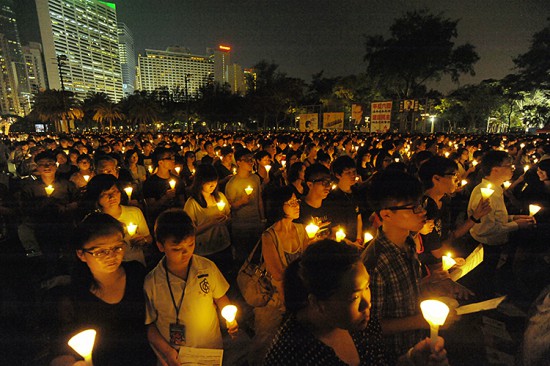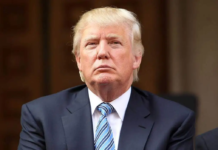180,000 attend ‘6.4’ anniversary protest • Rival protest events show political polarisation
Nate Norman and Jaco Lam, Socialist Action (CWI Hong Kong)
On the 25th anniversary of the Beijing massacre, Hong Kong’s candlelight vigil commemorating those killed had a strong turnout of 180,000 people, topping the past two years’ attendance. As demonstrations of this type are completely banned in the rest of China, the massive turnout in Hong Kong’s Victoria Park again sends a powerful signal. “Never forget June 4” has become a rallying cry, encouraging Hong Kong residents to continue the fight against the Chinese Communist Party (CCP) dictatorship.
In China, unrest is growing among workers, students and national minorities. At the same time, CCP leader Xi Jinping is increasing the state’s repressive controls, with an ongoing crackdown against dissidents, strike leaders, bloggers and human rights lawyers, including moderate critics who do not oppose the CCP but merely urge reforms and greater transparency. In Hong Kong, a potentially massive clash is looming over the CCP’s broken promises to allow a democratic election system (universal suffrage) for choosing the territory’s government. These tensions were very near the surface at the mass candlelight vigil.

Fight for ‘public nomination’
Union leader Lee Cheuk-yan is chairperson of the Hong Kong Alliance in Support of Patriotic Democratic Movements in China, which stages the vigil every year. He urged the crowds to join the demonstration on 1 July (another major annual protest) to demand the government allow ‘public nomination’ for upcoming elections and abolish the undemocratic business-based ‘functional constituencies’, which make up half the seats in Hong Kong’s legislature. The CCP and the Hong Kong government which is under its control have flatly ruled out ‘public nomination’ i.e. the possibility of candidates not pre-approved by the dictatorship.
The loudest cheers of the evening were for Teng Biao, a human rights lawyer from Beijing, who urged the crowd to support the Occupy Central movement and demand full democracy in Hong Kong. He said the CCP had elevated its notorious “stability maintenance” to a political cleansing with an endless wave of arrests.
For the first time, showing the political polarisation in the city, a pro-China group called ‘Voice of Loving Hong Kong’ staged a small provocative counter protest outside Victoria Park with a banner ‘Drop the historical baggage and move on’. Echoing the line of most CCP apologists, they told people to forget the 1989 massacre and concentrate on the ‘strong economic development’ in China today.
Hardly anyone can leave the mass June 4 vigil without being deeply impressed. These are emotional events and the size of the crowds is stunning. The Alliance, which organises the vigil, has come under growing criticism in recent years, however, for its de-politicisation of the Tiananmen issue, turning this into a ceremonial event rather than an explicit rallying point to step up the democracy fight in China and Hong Kong. This is also shown in increasing restrictions upon political groups campaigning inside the vigil area (Victoria Park) and more and more debate over the official slogans.
The slogan of last year’s vigil, “Love the country, Love the people. That’s the Hong Kong spirit!” drew a lot of criticism for being soft and conciliatory towards CCP-led nationalism. A backlash pressured the Alliance to drop this slogan. This year it adopted the more combative sounding, “Rectify the June 4 verdict, fight till the very end.” Even this call to ‘rectify’ Beijing’s official judgement is clearly addressed to the dictatorship. But what’s needed instead is a clear call for mass struggle to ‘rectify’ the monstrous dictatorial regime by sweeping it from power.

Disillusionment
These political controversies are not just about history but reflect today’s struggle, and the widespread perception that the opposition pan democratic parties in Hong Kong are backsliding in the face of the CCP’s hardline refusal to make concessions. These leaders, especially the Democratic Party, which also dominates the Alliance, have shown their primary strategy is to try to reach a compromise with the CCP. Rather than attempt to harness the power of the masses in struggle, the pan democratic leaders use this idea only as a threat to pressure Beijing. As it plays out, Hong Kong’s democracy struggle is proving this strategy is incapable of winning significant change.
Frustration among many people especially youth and internet ‘activists’ that the mainstream pan democratic parties are too ‘soft’ and lack the stomach for real struggle was shown in a 7,000-strong splinter vigil, held at the same time on June 4 in Kowloon, and hosted by Hong Kong-nationalist or ‘localist’ groups Civic Passion and the Proletariat Political Institute. While dwarfed by the crowd in Victoria Park, this turnout marks an enormous increase from last year’s attendance of 200 for the rival event.
The ‘localist’ gathering represents a very peculiar mix of more radical democratic demands and militant rhetoric, with dangerous right-wing populist and racist ideas. While the organising groups use racist propaganda against mainland Chinese people (rather than just targeting the CCP regime), the sizeable turnout to this vigil primarily reflects a layer searching for an alternative to the Alliance-led event, and rising disillusionment with the lack of fight shown by the main pan democratic parties who use the June 4 vigil as a platform for themselves. After this vigil, traffic was briefly blocked on Canton Road when many people began a spontaneous protest shouting slogans against the Chinese government. Such actions make them appear far more militant than the Alliance.

Revolutionary struggle needed
Socialist Action, the Hong Kong supporters of the CWI, made a strong intervention at the Victoria Park vigil, organising three tents at different entry points. We argue that universal suffrage cannot be won in Hong Kong as long as the CCP is in power. The struggle in the city is inseparable therefore from the need for mass struggle in China. One of the most important things to be learnt from the massacre in 1989, which helped to forge the current regime’s ruling mentality combining authoritarian government and capitalist economics, is that the CCP will not be reformed away, but must be challenged by a mass movement and overthrown. The recent historic strike of 50,000 shoe workers in April shows the potential power of the working class as the main force for change in society.
The 1989 movement was a revolutionary struggle, but tragically only one side – the CCP dictatorship – had a clear strategy and leadership that was prepared to go to terrible lengths in order to prevail. The lesson from this, written in blood, is the vital need for an organised working class alternative with a programme to abolish one-party dictatorship, which must include immediate and full democratic rights as well as democratic control over the economy to meet society’s needs.





